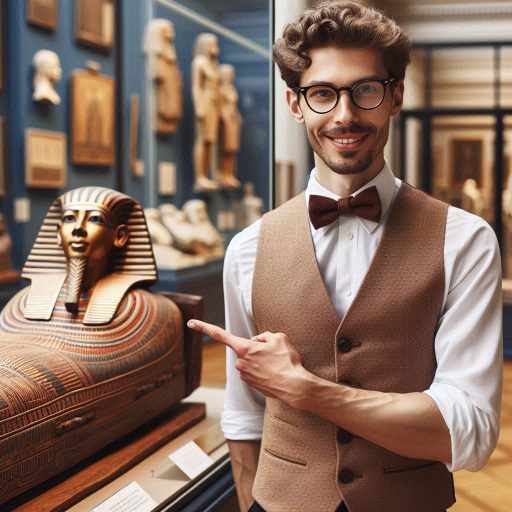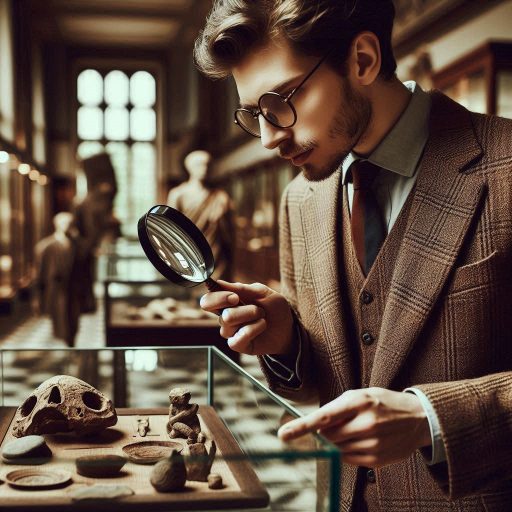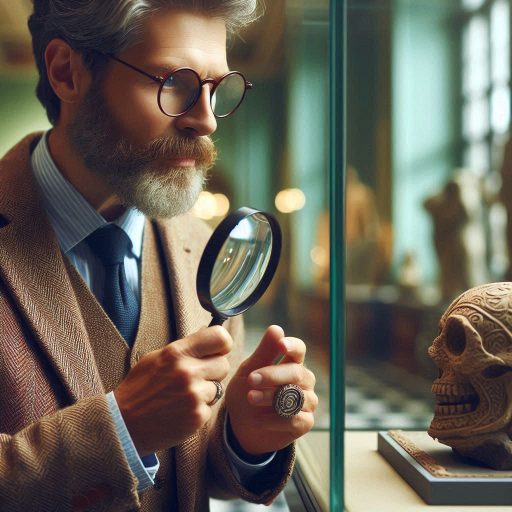Introduction
Art curation involves the selection, organization, and presentation of art pieces for exhibitions or collections.
It encompasses understanding various art forms, historical contexts, and the narratives behind each work.
For beginners, art curation is crucial because it fosters an appreciation for art and enhances the ability to communicate ideas effectively through visual storytelling.
Engaging in art curation allows individuals to explore their tastes, learn about different styles and movements, and connect with artists and the broader art community.
In this blog post, we will cover essential aspects of art curation for beginners.
We will discuss how to research various art styles and movements, develop your personal taste, and build a meaningful art collection.
Additionally, we will explore preservation and maintenance practices to ensure the longevity of your artworks.
Finally, we will address the importance of networking within the art community to enhance your curation journey.
By the end of this post, you will be equipped with valuable insights to start your art curation adventure.
Research and Exploration
Starting a career in art curation begins with research and exploration.
Understanding different art styles, movements, and history is crucial for curators.
This foundational knowledge helps develop an informed perspective when selecting and organizing art pieces.
Whether you’re curating an exhibition or just exploring your interests, research plays a vital role in shaping your approach.
How to Start Researching Different Art Styles and Movements
The first step in art research is to familiarize yourself with various styles and movements.
Start by studying the major periods in art history, such as Renaissance, Baroque, Impressionism, and Modernism.
Each period offers unique characteristics that define the works produced during that time.
Knowing these traits helps you recognize patterns and themes in art, making it easier to classify and interpret pieces.
Use books, online resources, and documentaries to dive deeper into specific movements.
Visiting online databases like JSTOR or museum archives can also provide scholarly insight.
Don‘t hesitate to take notes and highlight essential points.
When you encounter art that inspires or puzzles you, note what resonates and why.
This practice sharpens your ability to analyze and understand art more profoundly.
Tips on Exploring Local Art Galleries and Museums
While books and online resources provide valuable information, nothing compares to viewing art in person.
Start by visiting local art galleries and museums to immerse yourself in a physical art experience.
This hands-on exploration offers direct exposure to various art forms, from contemporary works to classical masterpieces.
As you explore, observe how galleries organize their exhibitions.
Pay attention to how they group works and present themes.
Notice how lighting, space, and even the framing of each piece contribute to the overall experience.
These elements offer practical lessons in curatorial decision-making.
Try to engage with gallery staff, curators, or artists to learn their perspectives.
Their insight can deepen your understanding of how art is selected, displayed, and appreciated.
Many galleries and museums host events, workshops, or guided tours that offer further learning opportunities.
Participating in these programs allows you to ask questions and gain behind-the-scenes insights into the curatorial process.
If possible, attend artist talks to hear directly from the creators about their inspiration, techniques, and intentions.
The Importance of Understanding the History of Art
Understanding the history of art is essential for effective curation.
Knowledge of art history equips you with the context behind artistic movements, allowing you to see the evolution of ideas, techniques, and cultural influences.
This understanding provides depth when you‘re choosing pieces for exhibitions or writing descriptions for artworks.
Art history teaches you to appreciate the significance of a piece beyond its surface appearance.
Recognizing the historical and cultural contexts of art movements, will shape your interpretation of individual works.
By researching art history, you can curate exhibitions that resonate with the audience and provoke thoughtful reflection.
Read: Best Tools and Software for Character Designers
Developing your Taste
Cultivating your personal taste in art is a crucial step in becoming an effective curator.
Your taste reflects your unique perspective, allowing you to make informed decisions when selecting and displaying works.
Developing this taste takes time, and involves exploring various styles, mediums, and artists to discover what resonates with you.
The process is both intellectual and emotional, as it engages your senses and curiosity.
How to Cultivate Your Own Taste in Art
To develop your taste, expose yourself to as much art as possible.
Start by viewing a wide range of artistic expressions, from classical paintings to contemporary installations.
Engage with different periods, movements, and cultural influences to broaden your understanding.
By seeing a variety of works, you can identify recurring themes, ideas, or techniques that catch your attention.
Pay attention to your immediate reactions.
Whether a piece excites you or leaves you indifferent, these feelings offer insight into your preferences.
Ask yourself questions like: What do I find compelling about this artwork? Why am I drawn to a particular artist or style?
These reflections will help you form a more refined sense of what appeals to you.
Reading about art can also shape your taste.
Explore critiques, essays, or interviews with artists to gain different perspectives.
Sometimes, understanding the intention behind a work or its historical significance can alter your appreciation for it.
The more knowledge you acquire, the more your taste evolves.
Tips on Identifying What Resonates with You
Recognizing what resonates with you is key to curating effectively.
Trust your instincts when interacting with art.
Start by noticing what themes or emotions draw you in.
Are you fascinated by abstract works, or do you gravitate towards realistic portraits? Do bright, bold colors captivate you, or do you prefer subtle, monochromatic schemes?
Experiment with different forms of art to find connections.
For example, if you enjoy Renaissance paintings, see if similar traits appeal to you in photography or sculpture.
Sometimes, the qualities that resonate in one medium will carry over into another, helping you uncover patterns in your taste.
Additionally, document your experiences with art by keeping a journal.
Write down what you felt while viewing a particular piece, and why it stood out.
Over time, these entries will reveal your evolving preferences, and help you pinpoint what moves you the most.
You can also revisit older journal entries to see how your tastes have shifted.
Experimenting with Different Styles and Mediums
To truly cultivate your taste, it‘s essential to experiment with different styles and mediums.
Don‘t limit yourself to one category of art.
Try exploring unconventional or experimental pieces that challenge your perspective.
Engaging with different forms of art‘whether digital media, sculptures, or performance art‘broadens your creative vision.
Consider immersing yourself in hands-on experiences as well.
Try creating art yourself, even if just for fun.
Experimenting with different mediums such as charcoal, oil paint, or photography will give you a deeper appreciation of the techniques and challenges artists face.
This process of creation can refine your understanding and sharpen your ability to evaluate art more critically.
Developing your taste in art is a journey of exploration and reflection.
Read: Ceramic Art: From Hobby to Professional Career
Building your Collection
Starting an art collection can be both exciting and rewarding.
Whether you’re an aspiring curator or an art enthusiast, building a collection allows you to express your unique taste and support artists.
However, collecting art requires a thoughtful approach, especially when working on a budget.
By learning how to evaluate artwork and exploring different ways to acquire pieces, you can create a meaningful and affordable collection.
Tips on Starting a Collection on a Budget
Building an art collection doesn’t have to be expensive.
Start by setting a clear budget and identifying what you‘re willing to spend on individual pieces.
It’s possible to find affordable art through local galleries, online platforms, and emerging artists.
Look for pieces that align with your taste but are still within your price range.
Consider focusing on prints, limited editions, or works by lesser-known artists.
Prints and editions are more affordable than original paintings but still offer artistic value.
Emerging artists often sell their work at lower prices, providing an opportunity to collect high-quality pieces early in their careers.
Attend art fairs, student exhibitions, and open studio events to discover new talents.
You can also explore online marketplaces like Etsy or Saatchi Art, where many artists sell their work directly.
These platforms offer access to a variety of styles and mediums, allowing you to explore options within your budget.
Be patient and take the time to search for hidden gems that resonate with you.
How to Evaluate the Value of Artwork
Evaluating the value of artwork goes beyond its price tag.
To assess value, consider factors such as the artist’s reputation, the piece‘s uniqueness, and the quality of materials used.
Start by researching the artist‘s background.
Is the artist established, emerging, or unknown?
Established artists with a significant exhibition history tend to have higher-value works, but emerging artists can also offer promising investments.
Consider the rarity of the piece.
Limited edition prints or one-of-a-kind works typically hold more value than mass-produced items.
Examine the quality of materials as well.
Higher-quality materials, like archival paper or premium oil paints, increase the artwork’s longevity and value.
The piece‘s provenance‘its ownership history‘also contributes to its value.
If an artwork has been exhibited in reputable galleries or owned by significant collectors, its value may be higher.
Additionally, seek out expert opinions if you’re unsure about a piece‘s worth.
Some galleries offer consultations or can connect you with art appraisers who specialize in evaluating artwork.
Various Ways to Acquire Art Pieces
There are several ways to acquire art, each offering a unique experience.
Galleries remain a traditional source for purchasing art.
Visiting a gallery allows you to view the piece in person and speak with knowledgeable staff about the artist and their work.
Many galleries offer flexible payment plans, making it easier to acquire high-quality pieces over time.
Art auctions are another option, offering the chance to acquire art at potentially lower prices.
However, auctions can be competitive, so it’s essential to research the artwork and set a strict bidding limit.
Online auctions offer a convenient way to participate from home and often feature a wide range of art at various price points.
You can also acquire art directly from artists.
Attending art fairs, open studios, or exhibitions allows you to meet artists and buy work without gallery commissions.
This approach is often more affordable, and you can build a personal connection with the artists you support.
Building your art collection is a personal and rewarding experience.
Read: How to Create Memorable Characters: Pro Tips

Display and Presentation
Displaying your art collection effectively is just as important as selecting the pieces themselves.
The way you curate, frame, and arrange your collection can elevate its impact and create a visually stunning presentation.
Transform Your Career Today
Unlock a personalized career strategy that drives real results. Get tailored advice and a roadmap designed just for you.
Start NowHow to Curate and Arrange Your Collection
Curating your collection involves selecting which pieces to display and deciding how to arrange them.
Start by thinking about the mood, theme, or message you want your collection to convey.
Are you highlighting specific styles, periods, or subjects?
Grouping pieces with similar elements, such as color schemes, themes, or techniques, creates visual harmony and enhances the viewer‘s understanding of the collection.
Consider the space where you‘ll display the artwork.
For smaller spaces, less is often more.
Avoid overcrowding by choosing a few standout pieces that can be arranged to complement the room‘s layout.
In larger spaces, you have more flexibility to experiment with different arrangements.
Try mixing various sizes and shapes of artwork to create dynamic visual interest.
The goal is to strike a balance between cohesion and diversity.
If you‘re unsure about an arrangement, experiment by laying the pieces on the floor or using paper templates on the wall to simulate how they‘ll look.
This gives you a chance to adjust the layout before hanging the art.
Tips for Framing and Hanging Artwork
Framing is crucial for both protecting your art and enhancing its presentation.
The right frame should complement the artwork without overpowering it.
For traditional works like oil paintings, ornate or classic frames may work well.
For modern or minimalist art, sleek, simple frames are often better suited.
Make sure the frame style matches both the artwork and the surrounding space.
When hanging artwork, consider the ideal viewing height.
A common guideline is to hang pieces so the center of the artwork is at eye level, roughly 57 to 60 inches from the floor.
If you‘re hanging multiple pieces in a row, align them by their center points rather than the tops or bottoms to create a cohesive look.
For larger collections, creating a gallery wall is a popular method.
This involves arranging multiple pieces of varying sizes in a cohesive, balanced layout.
When creating a gallery wall, start by placing the largest or most significant piece in the center, and arrange smaller works around it.
Keep equal spacing between frames for a clean, organized look.
Lighting is another important factor.
Use soft, focused lighting to highlight individual pieces, ensuring the artwork is well-lit without creating harsh shadows or glare.
Creating a Cohesive and Visually Appealing Display
To create a visually cohesive display, think about how each piece interacts with the others in the space.
Consider the overall color palette of the artwork and the room itself.
Pieces that share complementary colors or tones will create harmony, while contrasting colors can add drama and interest when used strategically.
Balance is key to a successful arrangement.
Avoid clustering too many pieces in one area, as this can make the display feel cluttered and chaotic.
Instead, aim for an even distribution of artwork throughout the space.
For a more organized look, use symmetry, such as pairing similar-sized works or arranging pieces in straight lines.
Asymmetrical layouts can add creativity and flow to your display if done thoughtfully.
Read: Ceramic Art Exhibitions to Visit in 2024
Networking and Community
Networking is essential in the art world, whether you’re an aspiring curator, collector, or simply an enthusiast.
Building relationships with fellow art lovers, artists, and galleries can provide valuable opportunities for collaboration, learning, and growth.
Engaging with the art community opens doors to discovering new artists, understanding industry trends, and even finding unique pieces.
In this section, we’ll discuss the importance of networking, how to connect with artists and galleries, and practical tips for attending art events and exhibitions.
Importance of Networking with Other Art Enthusiasts
Networking with other art enthusiasts allows you to share knowledge, discuss ideas, and gain new perspectives on art.
Being part of an art community encourages growth, as members often exchange recommendations on artists, galleries, and exhibitions worth exploring.
Surrounding yourself with people who share your passion creates a supportive environment that fosters both your personal taste and your understanding of the art.
Networking can also lead to collaborative opportunities, whether you’re organizing a joint exhibition or co-hosting a gallery talk.
These connections provide the chance to engage in creative projects that expand your horizons and introduce you to new audiences.
Moreover, networking can enhance your professional reputation, as it builds credibility and recognition within the art community.
How to Connect with Artists and Galleries
Building relationships with artists and galleries is key to deepening your understanding of the art world and growing your collection.
Start by reaching out to artists whose work resonates with you.
Many artists appreciate direct communication with collectors or curators, especially when the connection is genuine.
Follow them on social media, attend their exhibitions, and engage in conversations about their creative processes.
Expressing interest in their work and ideas can foster long-term relationships.
Galleries are also important hubs for networking.
Attend gallery openings and events regularly, as these settings offer opportunities to meet both artists and gallery representatives.
When visiting a gallery, don‘t hesitate to ask questions about the artwork, the artists they represent, or upcoming exhibitions.
Building a rapport with gallery owners or staff can lead to exclusive access to new collections, private viewings, or even early-bird offers on artwork.
Social media platforms, like Instagram and LinkedIn, are valuable tools for connecting with artists and galleries.
Engaging with their content, commenting on posts, and sharing their work within your network helps create meaningful, supportive relationships online.
These interactions, over time, can lead to invitations to private events or collaborations.
Attending Art Events and Exhibitions
Attending art events and exhibitions is one of the best ways to network and immerse yourself in the art world.
Doing some research before attending an event helps you engage in more meaningful conversations.
Familiarizing yourself with the featured artists, the theme of the show, and the gallery‘s reputation enhances your overall experience.
Arriving early or staying late often provides more opportunities for one-on-one interactions with artists, gallery staff, and fellow attendees.
During quieter moments, artists or curators may give informal talks or be available for questions.
Asking thoughtful questions about the inspiration behind a piece or the artist‘s creative journey is a great way to start a conversation.
After the event, maintaining communication with people you meet can lead to future invitations and collaborations.
Learn More: Essential Skills for a Successful Museum Curator Career
Preservation and Maintenance
Preserving and maintaining art is a crucial responsibility for any collector or curator.
Proper care ensures that art pieces retain their value, beauty, and integrity over time.
Whether you own paintings, sculptures, or photographs, understanding how to protect artwork from damage and deterioration is essential.
This section covers tips on proper care, how to protect your art, and the importance of investing in professional conservation and restoration services.
Tips on Proper Care and Maintenance of Art Pieces
Artworks require consistent care to maintain their original appearance and value.
The first step in proper maintenance is ensuring that your art pieces are displayed and stored in appropriate conditions.
Avoid placing artwork in direct sunlight, as UV rays can cause fading and discoloration over time.
Instead, choose a spot with controlled lighting, ideally using UV-filtered glass or Plexiglas for framed pieces to minimize exposure.
Another key aspect of caring for art is regulating temperature and humidity levels.
Extreme fluctuations can cause materials to warp, crack, or degrade.
For most artwork, maintaining a stable environment with temperatures between 65 and 75 degrees Fahrenheit and humidity levels around 40 to 50% is ideal.
Using dehumidifiers or air purifiers can help control these conditions in your home or storage space.
Regular dusting with a soft, dry cloth is also important, but be careful not to use harsh chemicals or cleaning agents, as they can damage delicate surfaces.
For framed artworks, periodically inspect the frame, matting, and backing for signs of wear or damage, and address any issues promptly.
How to Protect Artwork from Damage and Deterioration
Protecting your artwork from potential damage is a proactive way to ensure its longevity.
One of the most effective methods is proper framing, particularly for delicate or valuable pieces.
A high-quality frame not only enhances the visual appeal of the artwork but also provides physical protection.
Choose archival-grade materials like acid-free matting and backing to prevent long-term damage to paper-based artworks.
For sculptures and three-dimensional pieces, it’s important to provide a stable and secure base to avoid tipping or accidental falls.
Make sure that heavy pieces are properly mounted or anchored to prevent damage.
Additionally, placing art in high-traffic areas can increase the risk of damage, so consider the location carefully to avoid potential hazards.
Transporting artwork can also be risky, but using professional art movers and proper packaging materials, helps minimize the chances of damage during relocation.
When handling artwork, always use clean hands or wear gloves to prevent oils and dirt from transferring to the surface.
Importance of Investing in Conservation and Restoration Services
Even with the best care, some artworks will require professional conservation and restoration services over time.
Investing in these services helps preserve the original qualities of a piece and prevents irreversible damage.
If you notice any signs of deterioration‘such as cracks, discoloration, or mold‘consult a professional conservator promptly.
Conservators have the expertise and tools to restore artwork while respecting its original integrity.
Whether it‘s cleaning a painting‘s surface or repairing structural damage to a sculpture, professional restoration can extend the life of your collection and preserve its value.
Conclusion
This blog post covered essential aspects of art curation for beginners.
We discussed the importance of researching different art styles and movements.
Developing your taste in art is crucial for curating a meaningful collection.
Additionally, we explored how to build your collection and preserve your artwork effectively.
Starting an art collection may seem overwhelming, but it is achievable.
Begin by exploring local galleries and visiting museums.
Connecting with artists enhances your understanding and appreciation of art.
Engaging with the art world helps you develop your unique perspective.
For beginners, numerous resources are available to deepen your knowledge.
Books on art history and online courses can be particularly helpful.
Many galleries and museums also offer free educational events to expand your understanding and network.
Ultimately, art curation is a personal journey.
With dedication and the right resources, you can build a collection that reflects your passion.
Now is the perfect time to explore the art world and start curating your unique collection today!
[E-Books for Sale]
The Big Book of 500 High-Paying Jobs in America: Unlock Your Earning Potential
$19.99 • 500 High-Paying Jobs • 330 pages
Explore 500 high-paying jobs in America and learn how to boost your career, earn more, and achieve success!
See All 500 High-Paying Jobs of this E-Book
1001 Professions Without a Degree: High-Paying American Jobs You Can Start Now
$19.99 • 1001 Professions Without a Degree • 174 pages
Discover 1001 high-paying jobs without a degree! Unlock career tips, skills, and success strategies for just $19.99!




